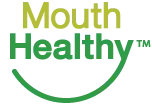Good oral health is important to your overall wellness. We have compiled resources for you to learn more about caring for your teeth and will keep you smiling.
Mouth Healthy
 Mouth Healthy is an online resource from the ADA created to help keep the public well informed on current oral care practices and ADA approved products. It is an excellent resource for patients of any age!
Mouth Healthy is an online resource from the ADA created to help keep the public well informed on current oral care practices and ADA approved products. It is an excellent resource for patients of any age!
Frequently Asked Questions
Caring for your Teeth:
Q: What are some tips for good oral health?
A: For smiles that are healthy on the inside and out:
- Always brush your teeth twice a day with fluoride toothpaste for two minutes
Floss between your teeth daily
Avoid sugary and starchy snacks
Wear a mouthguard when you’re playing sports
Don’t smoke
Don’t pierce your lips or any part of your mouth
See your dentist regulary
Q: How can I avoid getting cavities?
A: Brushing twice a day with toothpaste, flossing once a day, and limiting sugary snacks and beverages is how you can reduce your chances of getting a cavitiy.
Q: What are the dangers of drinking soda, energy drinks, and other high sugar beverages?
A: Soft drinks have emerged as one of the most significant dietary sources of tooth decay, affecting people of all ages. Acids and acidic sugar byproducts in soft drinks soften tooth enamel, contributing to the formation of cavities. Instead of drinking soda, it is recommened to subsitute sugar-free beverages. Also, brushing your teeth twice a day and regularly using fluoride products can reduce the negative impact of soda and other high sugar beverages on your teeth.
Dental Emergencies:
Question: What do I do if I knock out my tooth?
Answer: For a knocked-out permanent or adult tooth, keep it moist at all times. If you can, try placing the tooth back in the socket without touching the root. If that’s not possible, place it in between your cheek and gums, or in milk. Get to your dentist’s office right away.
Q: What if I crack my tooth?
A: For a cracked tooth, immediately rinse the mouth with warm water to clean the area. Put cold compresses on the face to keep any swelling down. See your dentist as soon as possible.
Q: If I bite my tongue or lip, how do I treat it?
A: If you bite your tongue or lip, clean the area gently with water and apply a cold compress. See your dentist or go to the emergency room as soon as possible.
Q: How do I treat a toothache?
A: For toothaches, rinse your mouth with warm water to clean it out. Gently use dental floss to remove any food caught between your teeth. Do not put aspirin on your aching tooth or gums; it may burn the gum tissue. If the pain persists, contact your dentist.
Q: What if I think my jaw is broken?
A: If you think your jaw is broken apply cold compresses to control the swelling. Go to your dentist or a hospital emergency department immediately.
Q: How do I remove an object that’s stuck in my mouth or teeth?
A: For objects stuck in the mouth, try to gently remove with floss but do not try to remove it with a sharp or pointed instrument. See your dentist or go to the emergency room as soon as possible.
Q: How can I avoid a dental emergency?
A: There are a number of simple precautions you can take to avoid accident and injury to the teeth:
- Wear a mouthguard when participating in sports or recreational activities.
- Avoid chewing ice, popcorn kernels and hard candy, all of which can crack a tooth.
- Use scissors, NEVER your teeth, to cut things
Caring for your Child’s Teeth
Q: When should I schedule my child’s first dental check-up?
A: As soon as your child’s first tooth appears, it’s time to schedule a dental visit. The ADA recommends that the first dental visit take place within six months after the first tooth appears, but no later than a child’s first birthday.
Q: How do I clean my young child’s teeth?
A: Begin cleaning your baby’s mouth during the first few days after birth by wiping the gums with a clean, moist gauze pad or washcloth. As soon as teeth appear, decay can occur.
When your child’s teeth begin to come in, brush them gently with a child-size toothbrush and water. A baby’s front four teeth usually push through the gums at about 6 months of age, although some children don’t have their first tooth until 12 or 14 months.
For children older than 2, brush their teeth with a pea-sized amount of fluoride toothpaste. Be sure they spit out the toothpaste. (Ask your child’s dentist or physician if you are considering using fluoride toothpaste before age 2.)
Until you’re comfortable that your child can brush on his or her own, continue to brush your child’s teeth twice a day with a child-size toothbrush and a pea-sized amount of fluoride toothpaste. When your child has two teeth that touch, you should begin flossing their teeth daily.
Reference: American Dental Association & Mouth Healthy
